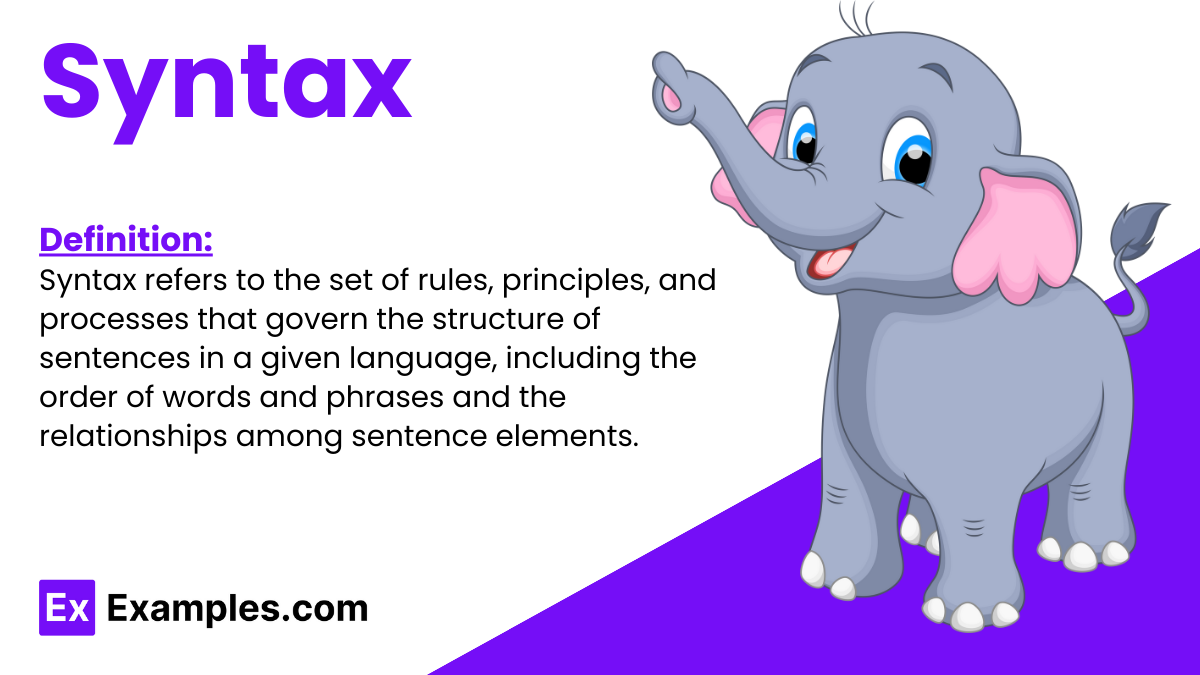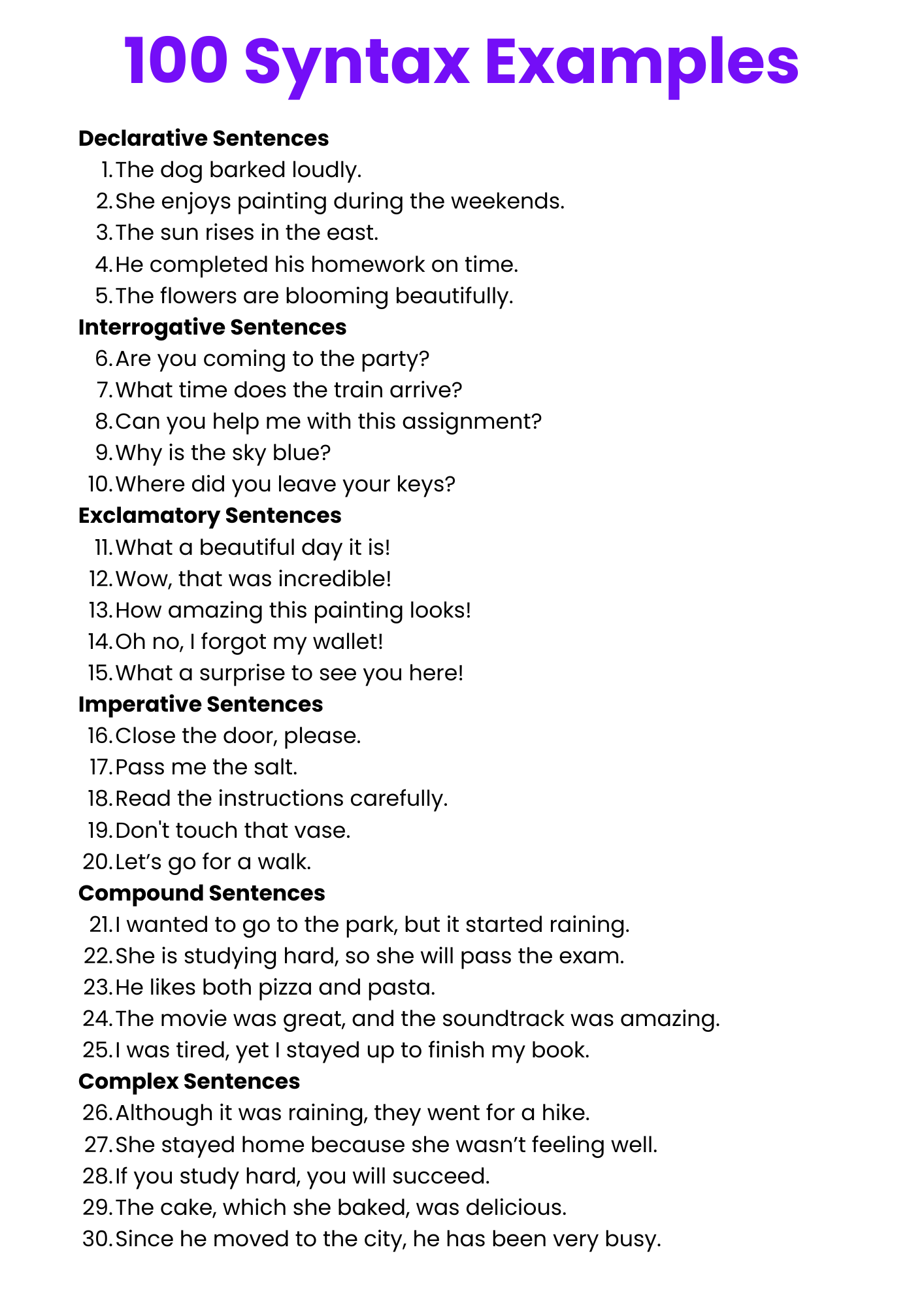Syntax
What is Syntax? – Definition
Syntax refers to the set of rules, principles, and processes that govern the structure of sentences in a given language, including word order, punctuation, and the relationship between words.

Generated Syntax Examples

Examples of Syntax
- Simple Sentence: “She reads.”
- Compound Sentence: “I wanted to go, but I stayed.”
- Complex Sentence: “Although it was raining, we went out.”
- Periodic Sentence: “Despite the heavy traffic, the train arrived on time.”
- Loose Sentence: “The concert was amazing, and everyone enjoyed it.”
- Cumulative Sentence: “After the meeting, we went out for dinner.”
- Inverted Sentence: “Rarely have I seen such dedication.”
- Interrogative Sentence: “Are you coming to the party?”
- Imperative Sentence: “Please close the door.”
- Exclamatory Sentence: “What a beautiful sunset!”
- Declarative Sentence: “She enjoys reading books.”
- Balanced Sentence: “He came, he saw, he conquered.”
- Cleft Sentence: “It was the teacher who explained the lesson.”
- Simple Complex Sentence: “Although he was tired, he finished his homework.”
- Compound-Complex Sentence: “While I enjoy reading, I don’t have enough time.”
- Negative Sentence: “She does not like broccoli.”
- Active Voice: “The chef cooked a delicious meal.”
- Passive Voice: “A delicious meal was cooked by the chef.”
- Imperative Sentence: “Close the door, please.”
- Declarative Sentence: “They are going to the park.”
- Complex-Compound Sentence: “Although it was raining, we went out, and we enjoyed the fresh air.”
- Declarative Sentence: “He writes every day.”
- Interrogative Sentence: “Do you like syntax exercises?”
- Exclamatory Sentence: “What an interesting syntax rule!”
- Balanced Sentence: “She likes reading, and he enjoys writing.”
- Periodic Sentence: “In spite of the challenges, she completed her thesis.”
- Cleft Sentence: “It is syntax that helps in structuring sentences.”
- Balanced Sentence: “He wanted to learn syntax, but she preferred semantics.”
- Imperative Sentence: “Review your syntax rules.”
- Declarative Sentence: “Syntax is essential for clear communication.”
Types of Syntax
Declarative Syntax
Sentences that make a statement or express an opinion.
- They are reading a book.
- She writes well, and he speaks fluently.
- Because the weather was nice, we decided to go for a walk.
- Although the task was difficult, the team persevered, and they achieved their goals.
- It is dedication that leads to success.
Interrogative Syntax
Sentences that ask questions.
- Are you coming to the party?
- What are you doing?
- Do you prefer tea or coffee?
- You’re joining us, aren’t you?
- Isn’t this a great day?
Imperative Syntax
Sentences that issue commands or requests.
- Close the door.
- Please hand me the book.
- Let’s go for a walk together.
- Join us for a dinner party.
- Don’t touch the artwork.
Negative Syntax
Sentences that express negation or denial.
- She does not enjoy loud noises.
- Rain isn’t always bad.
- I can’t attend the meeting tomorrow.
- He refuses to accept the offer.
- There are no exceptions to the policy.
Cumulative Syntax
Sentences that begin with a main clause and add subordinate elements.
- She arrived early, bringing her notes and preparing for the lecture.
- He completed the assignment, despite the challenging requirements.
- They reviewed the guidelines, making necessary adjustments to their essays.
- After finishing the project, she felt more confident in her skills.
- While working on the task, they discovered new methods to improve their work.
Inverted Syntax
Sentences where the typical word order is reversed for emphasis or stylistic reasons.
- Rarely have I encountered such dedication.
- Never before have I worked so diligently.
- Only after the meeting did he fully grasp the concept.
- Seldom do we see such perfect execution.
- Hardly had they finished the task when they moved to the next project.
How to Identify/Find Syntax?
Identifying syntax involves analyzing the structure of sentences, understanding the roles of different parts of speech, and recognizing various sentence types and patterns.
- Analyze the arrangement of words to determine the sentence structure.
- Identify the parts of speech and their functions within the sentence.
- Look for patterns such as subject-verb-object to understand sentence flow.
- Recognize different sentence types like declarative, interrogative, imperative, and exclamatory.
- Examine the use of clauses and phrases to determine complexity.
How to Apply Syntax in Sentences? – Rules
Applying proper syntax in sentences ensures clarity, coherence, and effectiveness in communication. Adhering to syntax rules helps structure your thoughts logically and enhances the overall quality of your writing.
- Maintain subject-verb agreement to ensure grammatical correctness.
- Use appropriate punctuation to clarify meaning and separate ideas.
- Structure sentences with clear clauses and phrases for better readability.
- Avoid run-on sentences by properly connecting independent clauses.
- Ensure parallelism in lists and comparisons to maintain consistency.
Other Syntax Examples
Simple Syntax
Involves a single independent clause with a subject and predicate.
- The dog barked.
- She reads books.
- He enjoys cooking.
- They are dancing.
- The sun is shining.
Complex Syntax
Combines an independent clause with one or more dependent clauses (introduced by subordinating conjunctions like because, although, since).
- Although she was tired, she finished her homework
- He stayed indoors because it was raining.
- When the movie ended, everyone clapped.
- She couldn’t go out until her work was done.
- If you study hard, you will succeed.
Compound Syntax
Combines two or more independent clauses joined by a coordinating conjunction (e.g., and, but, or), a semicolon, or a conjunctive adverb.
- I wanted to go swimming, but the pool was closed.
- She loves to read, and he prefers to watch movies
- The storm passed; the sky cleared.
- We can go to the park, or we can stay home.
- The coffee was strong, so I added some milk.
Compound-complex Syntax
Contains at least two independent clauses and one or more dependent clauses.
- I wanted to go for a walk, but it started raining because the clouds were heavy.
- She likes baking, and she enjoys gardening when she has free time.
- Although the train was late, we waited at the station, and we talked about our plans.
- I read the book, but I didn’t like the ending because it was predictable.
- We went to the beach, and we swam in the ocean while the sun set.
Explore Other Literary Devices
Elevate Your AP English Preparation
Unlock your potential with our comprehensive AP English exam preparation tools designed to help you excel.
- Extensive Question Bank: Access 900+ exam-like questions for both AP English Language and Literature.
- Expertly Crafted: Questions mirror the structure and difficulty of actual AP exams, ensuring relevant practice.
- Detailed Explanations: Understand your mistakes with clear, concise breakdowns of correct and incorrect answers.
- Personalized Learning: Tailor your study sessions with topic-specific tests and adaptive learning tools.
- Comprehensive Coverage: Master all aspects of the AP English curriculum with extensive guides and resources.
Frequently Asked Questions
-
What is syntax?
Syntax refers to the set of rules that govern the structure of sentences in a language, including word order, punctuation, and the relationships between words. -
How does syntax differ from grammar?
While grammar encompasses all rules governing language, including morphology and semantics, syntax specifically focuses on the arrangement of words to create well-formed sentences. -
Why is syntax important in writing?
Proper syntax ensures clarity and coherence in writing, making it easier for readers to understand the intended message. It also enhances the aesthetic quality of the text. -
How can I improve my understanding of syntax?
Practice by analyzing sentence structures, studying different types of sentences, and engaging in exercises that focus on sentence construction and variation. -
Can syntax affect the meaning of a sentence?
Yes, changing the syntax can alter the emphasis, tone, and sometimes the meaning of a sentence. Proper syntax ensures that the intended message is conveyed accurately.

